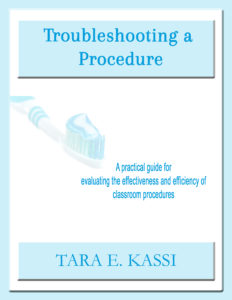Creating an Effective Process in 10 Steps
At no other time, do teachers think more about routines and procedures, than at the beginning of the school year.
The word routine rolls off the tongue of seasoned teachers as well as first year teachers. Not one teacher I know would deny the power of a routine for a well-ordered classroom.
Inevitably, some routines and procedures, put in place in August with the best of intentions, seem to fail by September, creating frustration for both teacher and student. Fear not! This year can be different. You can create effective and efficient routines and procedures.
The Power of Automaticity
How much time and mental effort do you give to brushing your teeth? Most likely, very little. Brushing your teeth is effortless. Why?
You’ve repeated the steps so many times, in the exact same order, that it has become a habit. You don’t have to think about it, you just do it.
In fact, you can think of other ideas, make plans, and come up with solutions while brushing your teeth. Why? Because brushing your teeth has become automatic that it frees up your brain to do something else.
This same kind of automaticity is what you are trying to create for students when establishing procedures in the classroom.
Automaticity is the point at which students are following procedures but exerting minimal cognitive resources. Actions are automatic, like reflexes.
Turning procedures into routines takes work, but it is worth it, allowing teachers to spend more time on teaching and learning rather managing a procedure that still isn’t working in December.
Understanding how a process is put together and why it works (or fails to work) can help you make small modifications to new or existing procedures and routines that will increase their effectiveness in the classroom and the likelihood of their success.
Unintended Consequences
Many use the words process, procedure, and routine interchangeably. I do not and I will show you why.
A process is a sequence of actions for the purpose of achieving a predetermined outcome. The weight of this definition lies in the phrase “a predetermined outcome.”
A procedure is a series of steps completed in a particular order. A procedure may or may not have a predetermined outcome; it is simply a series of sequential steps.
The distinction between a process and a procedure is the “predetermined” outcome.
No doubt, something will result from completing a procedure, but unless the outcome is intentional, the procedure could unintentionally lead to classroom chaos, student boredom, or all-around frustration. You have to be intentional and clear about defining the result and your reason has to be important and engaging.
A Few Examples
Example #1 – Teachers develop a procedure for turning in student work so that the teacher can grade and return the work. Is it really so that you can check the papers and record another grade?
Rather, the procedure is a structure for communication between teacher and student. Students turn in work so that the teacher can provide feedback to the student about their progress. If they don’t turn in the work according to procedure, then you can’t provide the feedback they need in a timely manner.
Example #2 – Teachers set up a morning routine for students so they can get settled in their seats quietly and get ready to work.
Could it be that the morning routine is really about teaching kids to manage themselves and complete tasks independently thus setting themselves up for success, and the by-product is that kids are quiet and in their seats? Realistically, if it is about the former, then getting kids quiet and in their seats can be accomplished much more effectively and in a shorter amount of time with a class cue.
This may seem like mincing words, but how you frame the procedure to yourself and the students makes all the difference.
Are you nagging a student for not properly placing their name on the paper, or are you conversing with a student about their academic progress and ability to complete tasks independently?
Students need to understand the reason behind the procedure and also how it benefits them.
The Pay-Off
The reward of practicing and reinforcing procedures is that they become habits, or routines. The beauty of a routine is its automaticity. Consistency in reinforcement is the key to creating automaticity, and is much easier to maintain when you have a clear vision for the outcome you want. Are you ready to get started?
10 Steps for Creating an Effective Process:
Step 1: Identify the process and state the desired outcome
Step 2: Know the students
Step 3: Identify any resources students need to complete the steps
Step 4: Break down the process into all of its component parts
Step 5: Order the steps in the process
Step 6: Walk through the process to identify challenges and barriers to success
Step 7: Name the process
Step 8: Communicate the process to students verbally & visually
Step 9: Model the process for students
Step 10: Enforce the process consistently until it is automatic
As the new school begins, think first about what you are trying to accomplish before you create or establish procedures. Then intentionally design procedures that you will consistently reinforce until those procedures become routines.
Click on the image below to sign up for my newsletter and
Download the free guide Troubleshooting a Procedure.

